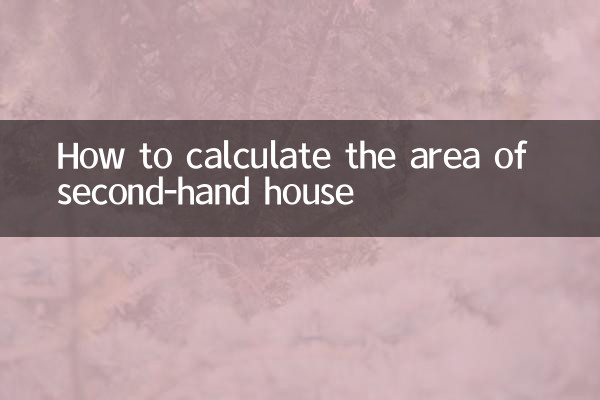How to calculate the area of a second-hand house? Comprehensive analysis of area calculation rules and pit avoidance guidelines
Recently, the popularity of the second-hand housing transaction market has continued to rise, but the calculation of house area has become the focus of disputes between buyers and sellers. This article combines hot topics on the Internet to sort out the calculation methods, common pitfalls and countermeasures for second-hand house area, helping you to avoid pitfalls easily.
1. Core rules for calculating the area of second-hand houses

The area of second-hand houses is usually divided intoBuilding area,Inner areaandPool areaThree types, the specific calculation methods are as follows:
| area type | Calculation formula | Inclusion |
|---|---|---|
| Building area | Apartment area + common area | The area enclosed by the center line of the exterior wall of the house |
| Inner area | Usable area in the suite + wall area in the suite + balcony area | actual available space |
| Pool area | Building area × shared coefficient | Public areas such as elevator shafts and stairwells |
2. Reference for sharing coefficients of different building types
According to data from the Ministry of Housing and Urban-Rural Development, the common residential share ratios in 2023 are as follows:
| Building type | Sharing coefficient range | Typical cases |
|---|---|---|
| Multi-story residential buildings (below 7 floors) | 10%-15% | Old style unit room |
| Small high-rise residential buildings (7-11 floors) | 15%-20% | Commercial housing after 2010 |
| High-rise residential buildings (12-33 floors) | 20%-28% | New elevator apartment |
| Super high-rise residential buildings (above 34 floors) | 28%-35% | city landmark building |
3. Recent Hot Controversies: The Free Area Trap
Hot topics on social platforms in the last 10 days"Buy a house and get free area"Issues worth alerting:
1.Common tactics used by developers:Convert equipment platforms, bay windows, etc. into "gifted areas", but such modifications may be illegal construction
2.Legal risks:A recent court ruling in a certain area shows that home buyers need to bear the demolition losses caused by illegal renovations.
3.Correct understanding:The area registered in the property ownership certificate is the legal basis for transactions.
4. Guidelines for handling area differences
When there is a difference between the actual measured area and the contracted area, the following rules should be followed:
| difference ratio | Processing method | Legal basis |
|---|---|---|
| ≤3% | More refunds or less compensation according to the contract price | Article 20 of the "Measures for the Administration of Commercial Housing Sales" |
| >3% | The buyer has the right to check out or request a double refund of the price difference | Judicial Interpretation of the Supreme People's Court |
5. Four-step method for second-hand house area verification
1.Verify title certificate:Focus on the three data items of "house construction area", "proprietary construction area" and "shared construction area"
2.Field measurements:Use laser rangefinder to check the size of main functional areas
3.Query files:Go to the real estate registration center to retrieve the original survey and mapping report of the house
4.Professional home inspection:Spend 300-500 yuan to hire a professional home inspector to issue an inspection report
6. Important reminders of new regulations in 2023
1. Many places have implemented the "what you see is what you get" sales model, requiring that model rooms must be consistent with delivery standards.
2. The Ministry of Housing and Urban-Rural Development’s new regulations require developers to publish detailed plans of public stalls at the sales office.
3. Some cities are piloting the "in-unit area pricing" system, but the total house price will not be reduced as a result.
It is recommended that home buyers be sure to ask the seller to provideLayered house floor planandArea calculation instructions, and clearly write the area terms into the contract. If you find that the area has shrunk by more than 5%, you can complain to the local housing and construction department or protect your rights through legal channels.

check the details

check the details